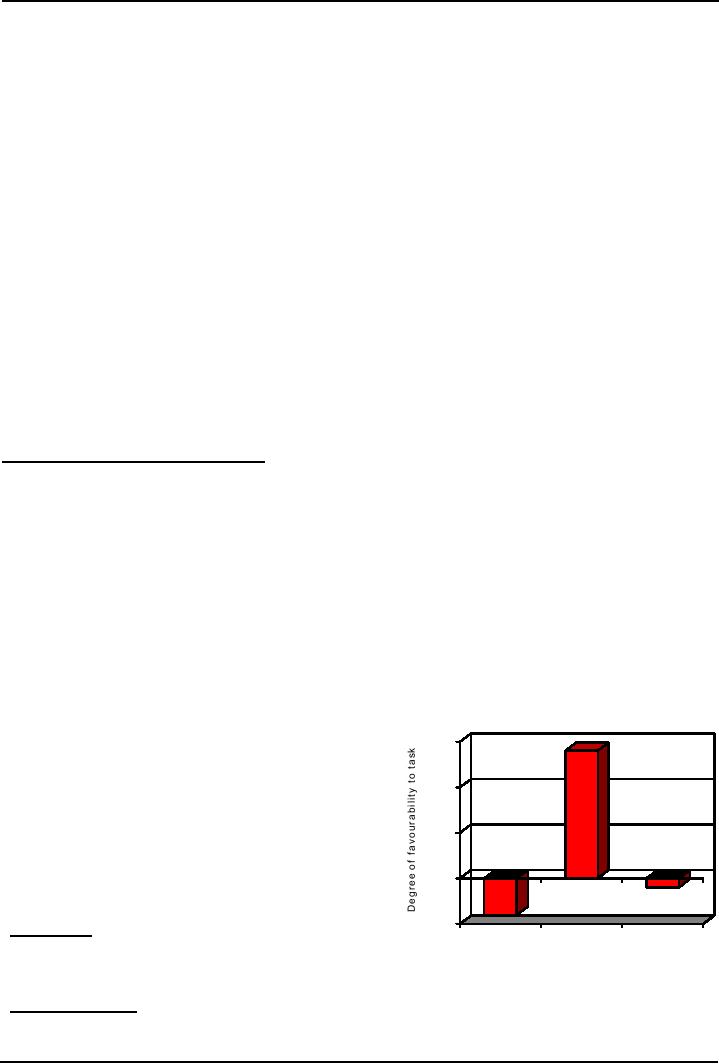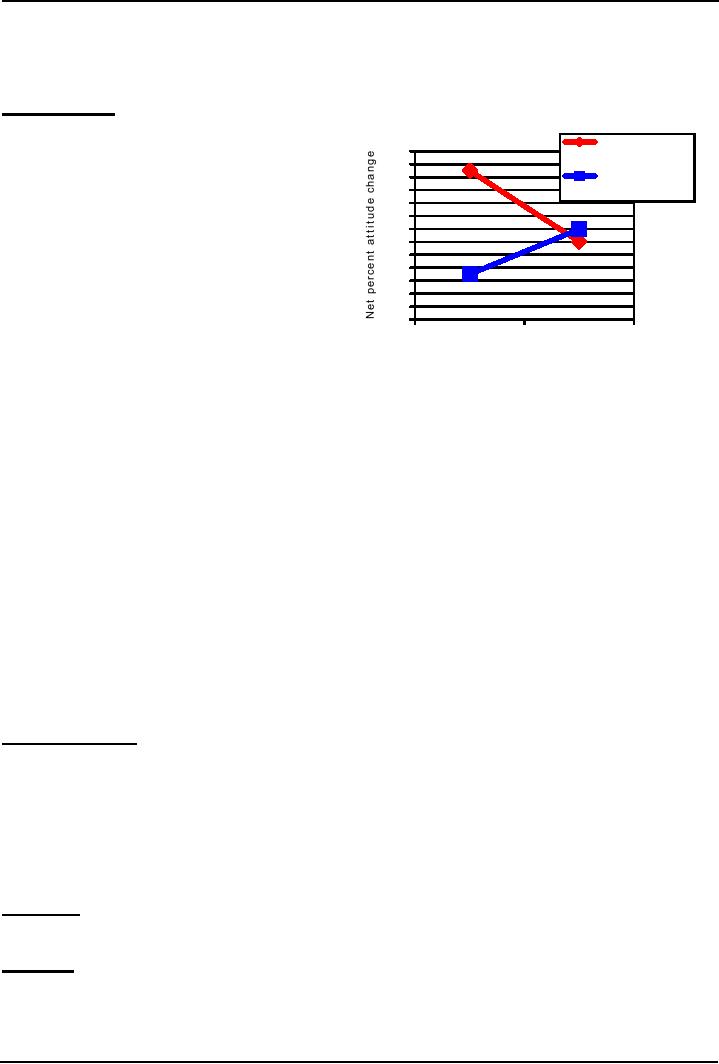 |

Social
Psychology (PSY403)
VU
Lesson
23
ATTITUDE
CHANGE
Aims
Introduce
the concept of attitude
change
Objectives
·
Describe the
motivational and external sources
for changing
attitudes
·
Describe
source variables that
influence the effectiveness of persuasive
messages
Behaviour
changing attitudes
From
self-perception theory (Bem,
1965) we know that we can
infer our attitudes from
observing our
own
behaviours (i.e., behaviours
can cause attitudes)
Ours
behaviours can also change
attitudes, if they are
unexpected...
Cognitive
dissonance theory (Festinger,
1957)
A
feeling
of discomfort caused by performing an
action that is inconsistent with
one's attitudes
Principle
of Cognitive consistency were first
introduced by Fritz Heider
(1946)
A
motivational
instead of a cognitive approach; has
Gestalt roots that human beings not
only expect and
prefer
their perceptions to be coherent but they
are motivated to do
so.
Festinger
maintained that instead of engaging in
rational behaviour, we often
engage in irrational and
maladaptive
behavior, and much of the time we
engage in rationalizing our
behaviour.
Festinger
& Carlsmith's study
(1959)
Participants
perform a boring task
(emptying and filling trays;
turning 48 wooden pegs)
Told
to lie to next participant
(it's a great task!)
$1
vs. $20 payment for
lying
An
interviewer then asks how
fun and interesting you in
fact found the tasks to be
Which
condition will lead to greater
favourability or attitude
shift?
Findings
are counter to what operant conditioning
would suggest (attitudes rewarded more
will be more
favourable)
BUT...$1
participants experienced a greater inconsistency
(dissonance) between their attitude
and
behaviour
than $20 participants (and unpleasant
state), i.e., `It was a
boring task', `I told
someone it was
fun'.
Festinger maintained that like
hunger dissonance is analogous to hunger
in aversiveness.
The
$1 participants have insufficient
justification so the
only
way to resolve the unpleasant inconsistency is
to
Effects
of payment on attitudes
change
their attitude to be in line
their behaviour (`The
to
dull task
task
was fun!')
Two
inconsistent cognitions led to either
adding a third
1.5
cognition
or by changing attitude. We need to be
able to
explain
why we do things. The $20
participants can
1
explain
their attitude behaviour inconsistency
through
reward
(the $20 was a sufficient
justification for the
behaviour)
by adding a 3rd cognition to
explain their
0.5
counter
attitudinal behaviour. However, $1
participants
changed
their attitude to maintain
consistency.
0
Factors
affecting dissonance
-0.5
Justification;
e.g., Doomsday cult group (as
referred in
No
payment-no $1 payment to $20
payment to
previous
lectures) transformed the bad experience into
a
lie
(control)
lie
lie
good
one to reduce dissonance
Freedom
of
choice: e.g., if we are forced to do
something this explains why we
did it in contravention of
our
attitudes, so it does not
create dissonance.
89

Social
Psychology (PSY403)
VU
Investment:
e.g.,
supporting a political party even
when evidence of incompetence, immorality,
etc.
escalates
(refuse to accept evidence of impropriety
because of all the time
invested in believing the
party's
ideals)
Cognitive
dissonance and
Persuasion
Cognitive
dissonance is attitude change
via an internal discrepancy
Persuasion
is attitude change via an
external message
Persuasion
is the process of consciously attempting to
change attitudes through the transmission
of some
message.
Factors
that influence the
persuasiveness of a message
Source: Who
is communicating?
Message
variables: What is the content?
Audience: To
whom the message is
delivered?
Source
Factors: Who is
communicating?
Source
credibility
·Expertise
·Trustworthiness
Source
attractiveness
·Physical
appearance
·Likeability
·Similarity
Source
Factors: Credibility
"Propaganda,
to be effective, must be delivered. To be
delivered, it must be
credible"
Expertise:
Bochner
& Insko's study (1966):
Written powerful statements
claiming that about fewer
than 8
hours'
sleep is required for
effective functioning and same
statements were attributed to either to
eminent
psychologists
or YMCA director. Obviously, those
people who were told that
the statements were written
by
the eminent psychologist believed more in
the statements.
"We
are not won by arguments
that we can analyze but by tone
and temper, by the manner which is
the
man
himself"
Trustworthiness:
Walster
et al.'s study (1966) about
the arguments of either a convicted
criminal or a
judge
about the importance of police's
ability for maintaining law
and order than the rights of
criminals.
The
criminal's arguments appeared more
impressive to people because people
who argue for actions
that
benefit
them are not trusted, hence
they suffer from low
credibility. In contrast, those who argue
for actions
that
are contrary to their vested
interests have high
credibility.
The
`sleeper effect' low
credibility as a discounting
cue
The
delayed effectiveness of a persuasive
message from a noncredible
source
Hovland
& Weiss's study
(1951)
Read
article stating that nuclear
submarines were safe
Author
= Oppenheimer (nuclear physicist
supervising the construction of atom
bomb) vs. Pravda (Soviet
newspaper);
(High vs. Low credibility
for US students in
50's)
Persuasion
is not very straightforward and
uncomplicated; 4 weeks later
credibility lost its
effectiveness.
Other
studies have also shown the delayed
effects of credibility.
90

Social
Psychology (PSY403)
VU
Immediate
effect
- High credibility source
--> greater persuasion; Tested 4 weeks
later? not much
difference.
Explanation
of the sleeper
effect
The
sleeper effect
Source
memory:
·
Forgetfulness
over time: i.e., over
time,
High
credibility
people
forget where the
source
26
source
24
originated
from and only remember
the
22
Low-credibility
content
(so credibility of source
would
20
source
have
no effect) the credible
source
18
16
became
dissociated from the
message
14
12
10
·
Explains
increase in low
credibility
8
source
persuasion as well as decrease
in
6
4
high
credibility persuasion
2
0
·
Kelman
& Hovlan (1953) replicated
the
Immediate
Four
weeks
original
experiment but
reminded
Time
interval
participants
of the source before
their
attitudes
were reassessed. The
sleeper
effect
was removed.
Three
factors that promote the sleeper effect
(A
meta-analysis of over 70 studies by
Kumkale &
Albarrachin,
2004):
The
message must be convincing enough in
itself to lead to persuasion
Credibility
information given after the
message (or no processing of content
will occur)
The
low credibility source
information decays faster than the
message content
Source
Factors: Attractiveness enhances
persuasiveness
During
1920s when feminists were
demonstrating against female
inequality
Nephew
of Freud, Edward Bernays, used
attractive "liberated" women in an ad
campaign for the cigarette
industry
to serve as a "torch of freedom"
symbol.
Women
had a campaign with anti-smoking slogans
in 1929 Easter parade in
Manhattan.
Many
women adopted the "torch of freedom
habit
The
cigarette company's profits soared
with this newfound
"liberated-female" market
Factors
indicating attractiveness:
Physical
appearance
Attractive
university UG were more likely (41%) to
persuade fellow students to
sign a petition as
compared
to less attractive
(32%)
Commercials
use central or peripheral
route processing for
persuasion. Usually attractive
females are
used,
who are consciously placed in commercials to attract
male viewers and to induce
positive feelings,
using
the principle of classical conditioning,
without even making the viewer
conscious of this purpose.
That
is why this is called
peripheral route.
Likeability:
Merely
saying nice things is enough
to get people to like you
(Eagly & Chaiken,
1993)
Similarity:
Communicators
can be similar to their audience in a
number of ways:
Sharing
attitudes and values is the most
important condition (Simons et al.,
1970)
Similar
backgrounds
Appearance
91

Social
Psychology (PSY403)
VU
Reading
·
Franzoi,
S. (2003). Social
Psychology. Boston:
McGraw-Hill. Chapter 7.
Other
Readings
·
Lord,
C.G. (1997). Social
Psychology. Orlando:
Harcourt Brace and
Company.
·
David
G. Myers, D. G. (2002). Social
Psychology (7th ed.).
New York:
McGraw-Hill.
92
Table of Contents:
- INTRODUCTION TO SOCIAL PSYCHOLOGY:Readings, Main Elements of Definitions
- INTRODUCTION TO SOCIAL PSYCHOLOGY:Social Psychology and Sociology
- CONDUCTING RESEARCH IN SOCIAL PSYCHOLOGY:Scientific Method
- CONDUCTING RESEARCH IN SOCIAL PSYCHOLOGY:Evaluate Ethics
- CONDUCTING RESEARCH IN SOCIAL PSYCHOLOGY RESEARCH PROCESS, DESIGNS AND METHODS (CONTINUED)
- CONDUCTING RESEARCH IN SOCIAL PSYCHOLOGY OBSERVATIONAL METHOD
- CONDUCTING RESEARCH IN SOCIAL PSYCHOLOGY CORRELATIONAL METHOD:
- CONDUCTING RESEARCH IN SOCIAL PSYCHOLOGY EXPERIMENTAL METHOD
- THE SELF:Meta Analysis, THE INTERNET, BRAIN-IMAGING TECHNIQUES
- THE SELF (CONTINUED):Development of Self awareness, SELF REGULATION
- THE SELF (CONTINUE…….):Journal Activity, POSSIBLE HISTORICAL EFFECTS
- THE SELF (CONTINUE……….):SELF-SCHEMAS, SELF-COMPLEXITY
- PERSON PERCEPTION:Impression Formation, Facial Expressions
- PERSON PERCEPTION (CONTINUE…..):GENDER SOCIALIZATION, Integrating Impressions
- PERSON PERCEPTION: WHEN PERSON PERCEPTION IS MOST CHALLENGING
- ATTRIBUTION:The locus of causality, Stability & Controllability
- ATTRIBUTION ERRORS:Biases in Attribution, Cultural differences
- SOCIAL COGNITION:We are categorizing creatures, Developing Schemas
- SOCIAL COGNITION (CONTINUE…….):Counterfactual Thinking, Confirmation bias
- ATTITUDES:Affective component, Behavioral component, Cognitive component
- ATTITUDE FORMATION:Classical conditioning, Subliminal conditioning
- ATTITUDE AND BEHAVIOR:Theory of planned behavior, Attitude strength
- ATTITUDE CHANGE:Factors affecting dissonance, Likeability
- ATTITUDE CHANGE (CONTINUE……….):Attitudinal Inoculation, Audience Variables
- PREJUDICE AND DISCRIMINATION:Activity on Cognitive Dissonance, Categorization
- PREJUDICE AND DISCRIMINATION (CONTINUE……….):Religion, Stereotype threat
- REDUCING PREJUDICE AND DISCRIMINATION:The contact hypothesis
- INTERPERSONAL ATTRACTION:Reasons for affiliation, Theory of Social exchange
- INTERPERSONAL ATTRACTION (CONTINUE……..):Physical attractiveness
- INTIMATE RELATIONSHIPS:Applied Social Psychology Lab
- SOCIAL INFLUENCE:Attachment styles & Friendship, SOCIAL INTERACTIONS
- SOCIAL INFLUENCE (CONTINE………):Normative influence, Informational influence
- SOCIAL INFLUENCE (CONTINUE……):Crimes of Obedience, Predictions
- AGGRESSION:Identifying Aggression, Instrumental aggression
- AGGRESSION (CONTINUE……):The Cognitive-Neo-associationist Model
- REDUCING AGGRESSION:Punishment, Incompatible response strategy
- PROSOCIAL BEHAVIOR:Types of Helping, Reciprocal helping, Norm of responsibility
- PROSOCIAL BEHAVIOR (CONTINUE………):Bystander Intervention, Diffusion of responsibility
- GROUP BEHAVIOR:Applied Social Psychology Lab, Basic Features of Groups
- GROUP BEHAVIOR (CONTINUE…………):Social Loafing, Deindividuation
- up Decision GROUP BEHAVIOR (CONTINUE……….):GroProcess, Group Polarization
- INTERPERSONAL POWER: LEADERSHIP, The Situational Perspective, Information power
- SOCIAL PSYCHOLOGY APPLIED: SOCIAL PSYCHOLOGY IN COURT
- SOCIAL PSYCHOLOGY APPLIED: SOCIAL PSYCHOLOGY IN CLINIC
- FINAL REVIEW:Social Psychology and related fields, History, Social cognition